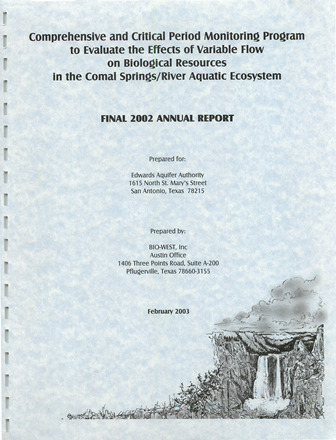Comprehensive and Critical Period Monitoring Program to Evaluate the Effects of Variable Flow on Biological Resources in the Comal Springs/River Aquatic Ecosystem Final 2002 Annual Report

| Summary |
|
The purpose of this report is to document the results of all aquatic ecosystem monitoring conducted in 2002 at Comal Springs located in New Braunfels, Texas. The monitoring and report preparation was performed by BIO-WEST, Inc. Pflugerville, Texas. [Excerpted from the Executive Summary] Aquatic vegetation has remained abundant throughout the study period (2000-present) and has provided suitable habitat for biological communities. In the Old Channel Reach, filamentous algae was nearly completely scoured in 2002 as it was by the flood in fall 2001. This is significant because of the importance of this vegetation type to fountain darters (Etheostoma fonticola). …[A]fter the summer 2002 flood, fountain darter densities were low relative to the previous sampling event. …As in the San Marcos River ecosystem, flooding has had significant short-term impacts on fountain darter habitat and the vegetation types with the greatest suitability were the most susceptible (filamentous algae and bryophytes)…. Two additional parameters were noted during fountain darter sampling, the density of giant ramshorn snails (Marisa cornuarietis) and evidence of gill parasites on fountain darters. … Drift net sampling for benthic macroinvertebrates was completed with the spring quarterly sample. In the spring runs and at the springs’ orifices, suitable habitat for the federally endangered invertebrates was observed throughout the study period. … Suitable habitat for the Comal Springs salamander (Eurycea sp.) was noted in the spring runs and Spring Island area; Comal Springs salamanders were observed in each area during each sampling event. … More data from lowflow periods (particularly from an extended low-flow period) are essential to fully evaluate the biological risks associated with future critical periods (high or low flow). …This study remains the most comprehensive biological evaluation that has ever been conducted on the Comal River ecosystem. |
Search for Documents
Advance Search
Explore EAA's Scientific Reports
- All Reports
- RZ Protection
- Aquifer Levels
- Remote Sensing
- Precipitation
- Overview Studies
- Modeling
- Hydrology and Hydrogeology
- History
- Groundwater Recharge, Recharge Zone
- Groundwater Movement
- Geomorphology and Caves
- Weather Modification
- Geology
- Water Use and Conservation
- Geochemistry
- Water Resources Planning and Management
- Floods and Drought
- Water Quality
- Climatology
- Surface Water / Groundwater Relationship
- Biology
- Springs, Groundwater Discharge
- Archaeology
